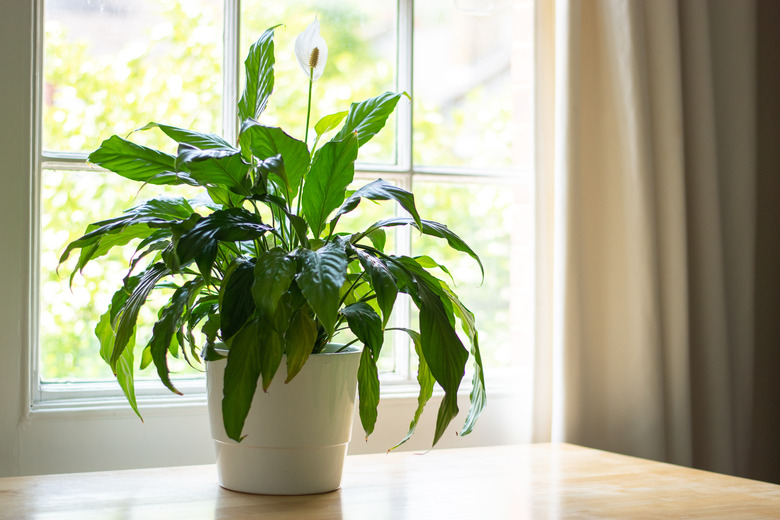Why Do Peace Lilies Get Curly Leaves?
We may receive a commission on purchases made from links.
It's disheartening to suddenly see your once-thriving peace lily (Spathiphyllum spp., U.S. Department of Agriculture plant hardiness zones 11 to 12) suddenly showcasing curling foliage. When it comes to causes, the main culprit of peace lily leaves curling is as simple as improper cultural practices. Correct the problem and before you know it, your peace lily will once again be sporting healthy leaves minus the curl for years to come. Peace lilies are mildly toxic, so keep them out of the reach of pets and children.
Tip
Not growing your peace lily in the cultural conditions it prefers, like proper lighting, temperature, and moisture, can cause the foliage to curl. You can prevent the problem by making sure the plant gets adequate moisture, humidity, and light and grows in preferred temperatures.
Curling Due to Improper Light
Curling Due to Improper Light
One of the causes of peace lily leaves curling is growing it in light conditions it doesn't prefer. Usually, this is due to the plant receiving too much direct light, whether grown outdoors or inside the home. To prevent foliage problems associated with curling, it's important to place the peace lily in light conditions promoting healthy growth. In their native habitat, peace lilies grow along the forest floor where the full sun doesn't penetrate.
To prevent leaf curling, place peace lilies grown outdoors in a location with full to partial shade. When grown indoors, place the peace lily in a bright location with indirect light, like an east-facing window. If you notice the foliage starting to curl, move the plant to a location with less light. Too much sunlight not only causes the leaves to curl but can scorch the foliage, making it unsightly by leaving brown burn marks that won't heal.
Curling Due to Improper Temperature
Curling Due to Improper Temperature
Those who live in a frost-free climate can grow peace lilies outdoors year-round. If you experience cooler winters, you can move a potted peace lily outdoors during the warmest portions of the year and move it back inside once temperatures start dropping. However, to prevent your peace lily's leaves from curling, move it to a cooler location when temperatures reach above 90 degrees Fahrenheit. On the other hand, outdoor and indoor plants suffer damage when extended temperatures drop into the mid 40s.
To prevent leaf curling in your indoor peace lily and keep the foliage looking great, situate it in a location where temperatures range between 68 and 85 degrees. Peace lilies can tolerate indoor temperature fluctuations of around 10 degrees without it affecting the foliage, but greater temperature fluctuations can see the leaves drooping. Be sure to situate the peace lily in an indoor location where it isn't affected by cold draughts, which can also cause curling and drooping leaves.
Curling Due to Inadequate Moisture
Curling Due to Inadequate Moisture
Not giving your peace lily an adequate amount of water and poor humidity also cause curling of the foliage. These are tropical plants native to jungle areas where the soils remain moist, and humidity is constant. Underwatering and overwatering can create drooping and curling foliage, with overwatering also causing the potentially life-threatening condition of root rot. Although peace lilies prefer a rich soil that remains moist through regular watering practices, it doesn't thrive in soils that remain constantly soggy. It's important to prevent problems with overwatering and rot by growing the peace lily in a pots with bottom drainage and in well-drained soils.
You can prevent problems with leaf curl by only watering the peace lily when the top several inches of potting mix become dry to the touch. Water until it runs from the pot's bottom drain holes. Don't let the plant sit in water; empty the catch tray once the pot has fully drained. Since peace lilies are sensitive to chemicals like fluoride, allow the water to sit for a day or two before using it and always water with room-temperature water.
It's easy to increase the humidity around the plant by misting all the foliage several times weekly. You can also set the pot on a tray of pebbles that collect moisture and create a humid environment around the plant. If the area gets enough light, you can also situate your peace lily in the bathroom, where humidity is present due to the continual use of water.
References
- Missouri Botanical Garden: Spathiphyllum (group)
- Almanac: Peace Lilies
- Bloomscape: Why Are the Leaves on My Peace Lily Drooping?
- Chicago Tribune: Bringing Peace Lily Back to Health Requires Attention to Its Growing Needs
- University of Florida IFAS Extension: Cultural Guidelines for Commercial Production of Interiorscape Spathiphyllum
